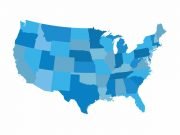The financial sector is dealing with uncertainty, and arguably has been from the moment the Federal Reserve decided to start progressively hiking the benchmark funds rate, putting financial institutions in a precarious situation. The good news for bank managers is that they have a workable, built-in response for unsatisfied clients by noting our central bank’s tightened monetary policies. Without being able to say when the Fed’s “fight against inflation” will end, we investors need to be extra careful when considering equities in this sector. Stocks representing banks, lenders, creditors, and anyone affected by the Fed’s rate increases should be approached carefully and only after considering what’s important.
I aim to display said importance by showing that even cautious and skeptical investors can be wrong in their assumptions and even pleasantly surprised. I’ll try something new with today’s recommendations— listing each stock’s PEG ratio. The PEG is calculated by dividing a firm’s P/E ratio by its forecasted long-term EPS growth (both of which are still important on their own). A PEG under 1.0 is considered promising since it indicates that the stock is undervalued. The lower, the better. So, why mid-cap banks? While I’m not usually one to offer a complacent answer, it can be surmised when looking at the list’s title. It’s fair to say that dividends, upside potential, and stability are all traits we like—banks or otherwise.
I’ve compiled three bank tickers that do well under market pressure, offer dividends, and are undervalued, accounting for heavy upside potential. Each with a sturdy buy rating, analysts and industry experts agree that these would make for profitable portfolio picks:
Western Alliance Bancorp (WAL)
Western Alliance Bancorp (WAL) boasts a varied and noteworthy portfolio of banks. WAL offers customized loans, deposits, and money management, offering transfers and digital payment options. WAL operates through full-service banking: First Independent, Alliance Bank of Arizona, Torrey Pines Bank, and the Bank of Nevada. WAL also offers mortgage banking through AmeriHome and digital payment services nationwide. WAL was founded in 1994 and is headquartered in Phoenix, AZ.
WAL is down by a staggering 46.42% YTD, but shows healthy metrics all around, leaving no room for genuine concern. WAL has a market cap of $3.5 billion and has TTM revenue of $2.5 billion at $9.70 per share, and with a net profit margin of 42.75%, WAL reported net income of just over $1 billion. WAL shows a P/E ratio of 3.3x, a forward P/E of 3.2x, and an excellent PEG ratio of 0.38x. WAL has a 10-day average trading volume of over 28 million shares and a free cash flow of $2.25 billion. WAL has a dividend yield of 4.51%, with a quarterly payout of 36 cents ($1.44/yr) per share. Analysts have given WAL a median price target of $83, with a high of $96 and a low of $50. As WAL currently sits at the bottom of its 52-week range, the median target represents a 160% price increase— its high mark reps over 200% potential upside. As one could likely surmise, analysts have given WAL a confident buy rating.
New York Community Bancorp (NYCB)
New York Community Bancorp (NYCB)’s nationwide presence includes warehouse financing, mortgage origination, and multifamily lending. NYCB focuses on non-luxury, rent-stabilized apartment buildings in New York City, acting as a lender. NYCB provides customized loans, leases, and other forms of specialist financing to large corporations in various industries. NYCB’s cash management services are also available to professional and small businesses. NYCB has hundreds of branches in nine different states. Roslyn Savings Bank, Richmond County Savings Bank, Ohio Savings Bank, and many more comprise NYCB’s regional branch locations. NYCB was founded in New York, NY, on April 14th, 1859, and its headquarters can be found in Hicksville, NY.
NYCB, with a market cap of almost $6 billion, has reported TTM revenue of $2.09 billion at $1.34 per share, from which it profited net income of $609 million— NYCB has a profit margin of 48.11%. With a P/E of 7.1x and a P/S of 1.79x, NYCB boasts an impressive PEG ratio of 0.45x. Despite a slight EPS miss on its last earnings report, NYCB surpassed analysts’ revenue projections by over 40%. NYCB is working with a cash flow of just over $1 billion and has a 10-day trading average of 43.2 million shares in volume. NYCB has a dividend yield of 7.76%, with a quarterly payout of 17 cents ($0.68/yr) per share and a payout ratio of 54%. Analysts have marked NYCB with a median price target of $11, with a high of $13 and a low of $8; this represents a price upside of 25.6%. Analysts concede; we should buy NYCB now.
Webster Financial Corp (WBS)
Webster Financial Corp (WBS) is a bank and financial holding company. Individuals, families, and businesses may use the banking, investing, and financial services offered by WBS and its subsidiaries. WBS’ InterLINK, a platform for deposit collection, provides broker-dealers with customized cash management solutions. WBS’ segments include Commercial, HSA, and Retail. Through its commercial operations, WBS offers asset-based financing, equipment lending, commercial leasing, specialty funding, and treasury solutions. Health-related savings accounts, reimbursement arrangements, and flexible spending accounts are all provided by WBS’ HSA Bank. WBS’s Retail division services consumers and small businesses. WBS was founded in Waterbury, CT, in 1935 and is headquartered in Stamford, CT.
WBS is down by 17.60% YTD, hinting at its undervalued nature. With a market cap of $7.1 billion and a free cash flow of $1.34 billion, WBS shows TTM revenue of $2.28 billion at $7.18 per share. WBS’ profit margin of 29% helped pull in net income of $622 million. WBS has a P/E of 7.3x, a forward P/E of 6.0x, and a noteworthy PEG ratio of 0.94x. For its most recent quarter’s earnings report, WBS exceeded projections by 54.48%; the quarter prior, 43.76%. WBS has a 10-day average volume of 3.5 million shares, with a debt to equity of 27.62% and YOY growth in revenue, EPS, and net income. WBS has a dividend yield of 4.10%, with a quarterly payout of 40 cents ($1.60/yr) per share, at a payout ratio of 43%. Analysts give WBS a median price target of $61.50, with a high of $75 and a low of $54. While the median would bring a 57.65% increase, the high mark would entail 92.3%. Even hitting WBS’ $54 low mark would mean an almost 40% upside. Analysts, increasingly bullish, agree that WBS has earned its buy rating. We should take note.
Read Next – No 1 Stock of the Decade
Interest rates…
Inflation
Banks failing…
The markets are CRAZY right now.
Which is why thousands of investors are flocking into one little-known company.
And if you’re looking for an inflation-beater, you should check it out.
Because this company has just discovered a breakthrough form of energy…
That could very well make it the #1 stock of the decade.
Because this company is about to kickstart what’s called an “energy supercycle.”
And based on early predictions, investors could be looking at 46,700% gains or more.
How’s THAT for beating inflation?















 and then
and then